In my role as a guest Expert Council member on The Survival Podcast, I received the following question from Matthew:
Can you please recommend a recipe for homemade spaghetti sauce without oregano? I love to grow tomatoes and I love homemade spaghetti sauce. My problem is my wife is very picky about spaghetti sauce. She will only eat Ragu from the store.
My wife absolutely despises oregano and really doesn’t like basil. So therein lies my dilemma. If you could please give me a recipe that omits oregano and is low on the basil I’d appreciate it because I haven’t found one in the past 5 years.
Okay, although I am personally not a fan of commercial sauces like Ragu compared to homemade pasta sauces, I do love a challenge! So I was happy to take a stab at developing a homemade pasta sauce that would appeal to folks who prefer that commercial sauce flavor.
Characteristics of a commercial pasta sauce like ragu
First things first: what makes a sauce like Ragu different from your typical homemade, seasoned tomato sauce? I picked up a jar of Ragu Traditional from the store to find out.
1. Tomato Paste Base
In reading the ingredient label, the first thing that stood out is that the sauce is made from tomato paste. In other words, the people at the Ragu factory don’t make their sauce by boiling down massive quantities of fresh tomatoes. They take already processed tomato paste and thin the paste out with water, then add spices and flavorings.
A good analogy here would making orange juice from concentrate but using only half the called for water, vs. squeezing oranges fresh for juice and reducing by half. You’re just going to get a very different flavor and texture when you start from a concentrated, smooth, pre-cooked-down base.
The tomato paste base impacts the color as well as the flavor of the sauce. Instead of the standard bright orangey-red of a homemade tomato sauce, the Ragu is a very dark red, almost like ketchup.
2. Dried Herbs and Spices
The second big thing I noticed is that the vegetables and spices in the sauce were all dried – including things like the onion. This made a difference to the mouth feel of the sauce. Unlike fresh onions, which become very soft after a long simmer, the dried onions in the Ragu had a toothsome quality even after whatever processing the commercial sauce underwent.
3. Sugar Content
The third big observation about this commercial pasta sauce is that it was quite sweet. There was hardly any noticeable acidity to Ragu sauce, and when I checked the label, sugar was very high up the ingredient list.
All tomatoes have some natural acidity, but the addition of lots of extra sugar will change the perceived flavor balance to something less tangy, and more smooth and sweet like the Ragu.
4. Thickness
My fourth observation – not really a surprise given that this sauce is basically a thinned down tomato paste – was the thickness of the sauce. The Ragu was closer in texture to what I think of as a thick pizza sauce than a pasta sauce The Ragu stands up on the spoon, and is notably slow to pour out of the jar.
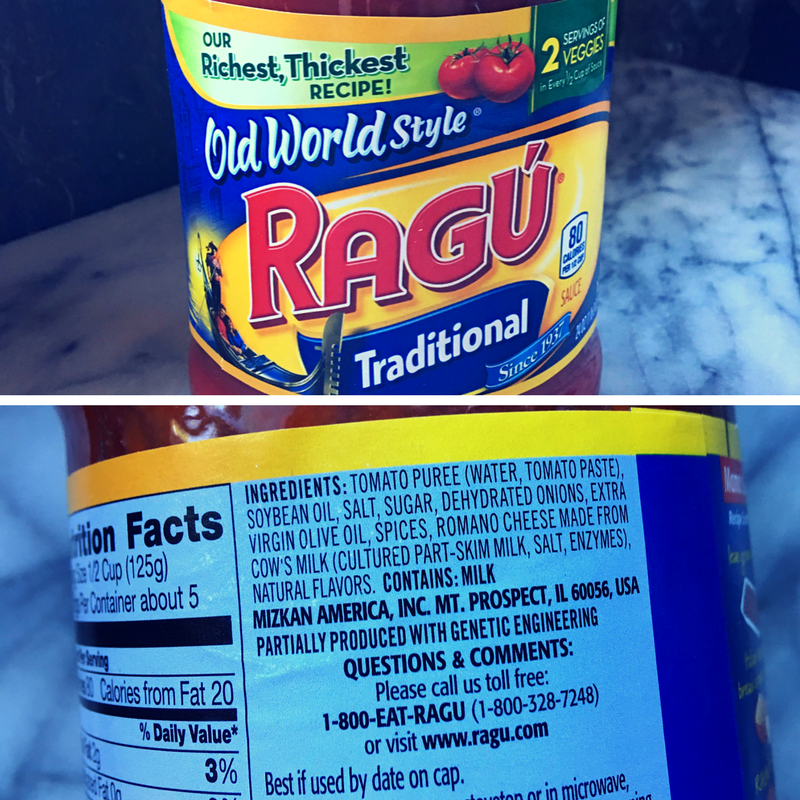
Takeaways For Our Homemade Sauce
If we want to win over folks who love that commercial style pasta sauce flavor, we need a homemade sauce with:
- A long-cooked, thick texture
- Moderately high levels of added sugar
- Minimal added acid
In general, making an appealing sauce for fans of store-bought Ragu is going to be less about oregano or specific spices, and more about duplicating the thickness and the round, mildly sweet flavor of a commercial sauce.
But, keeping in mind Matthew’s wife’s preferences, I did keep this particular pasta sauce oregano-free and fairly low in basil. As with all canning recipes you can swap out dry herbs and spices to your hearts content, with absolutely no effect on safety.
Notes on this pasta sauce recipe
1. Added Tomato Paste
I add commercial tomato paste to this recipe. There’s two reasons for this.
First, it will take you all flipping day to reduce 30 pounds of tomatoes down to something even close to commercial sauce thickness. A little help from the commercial tomato paste will get you to a thick sauce far faster and easier.
Second, the tomato paste helps add a little of that long-cooked, caramelized, paste-like flavor to the sauce. Think of it as pouring in a little orange juice concentrate into your pitcher of fresh squeezed orange juice, just to help ease the transition from commercial to homemade flavors.
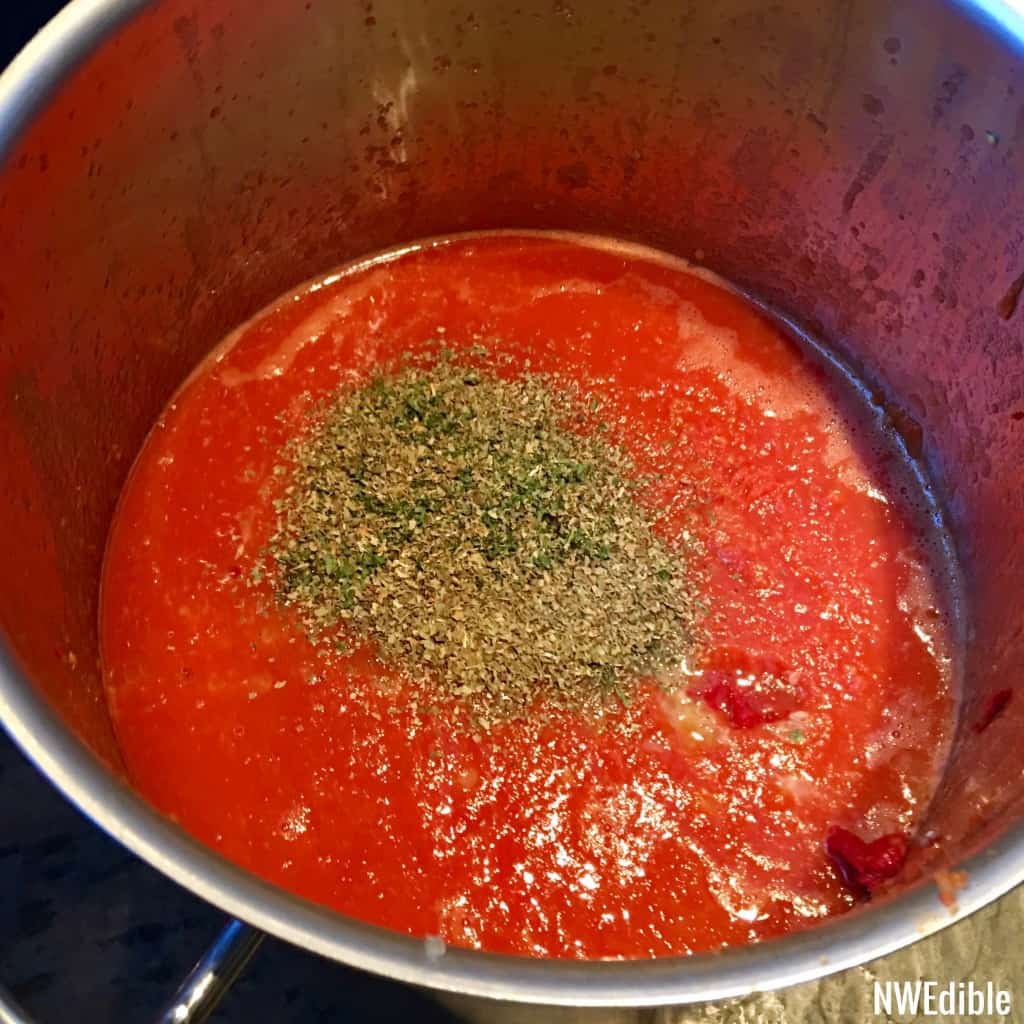
2. Pressure Canning
I’m calling for this sauce to be pressure canned. I developed this recipe by modifying a recipe that called for pressure canning originally, so that’s what I’m comfortable recommending.
Pressure canning also allows this sauce to be safely canned without the addition of citric acid or lemon juice, which would change the flavor of the sauce to something less like the smooth, mild flavor of the commercial sauce. (This is not a blanket statement about pressure canning tomatoes – I’m only speaking about this particular sauce.)
However, according to the Fresh Preserving website – which is the website of the Ball Canning Company – a recipe that is, at its core, very similar to this one can be water bath canned if 2 tablespoons of bottled lemon juice or 1/2 tsp of granular citric acid are added to every quart jar before processing.
If you go the water bath canning route with this recipe, you’ll want to dramatically reduce the oil down to 1.5 tablespoons, make sure you don’t increase low acid ingredients like onion or garlic at all, acidulate your jars with bottled lemon juice or citric acid according to standard tomato water bath canning procedures, and process quart jars 40 minutes in a boiling water bath canner.
Again, as this recipe is written, it must be pressure canned.
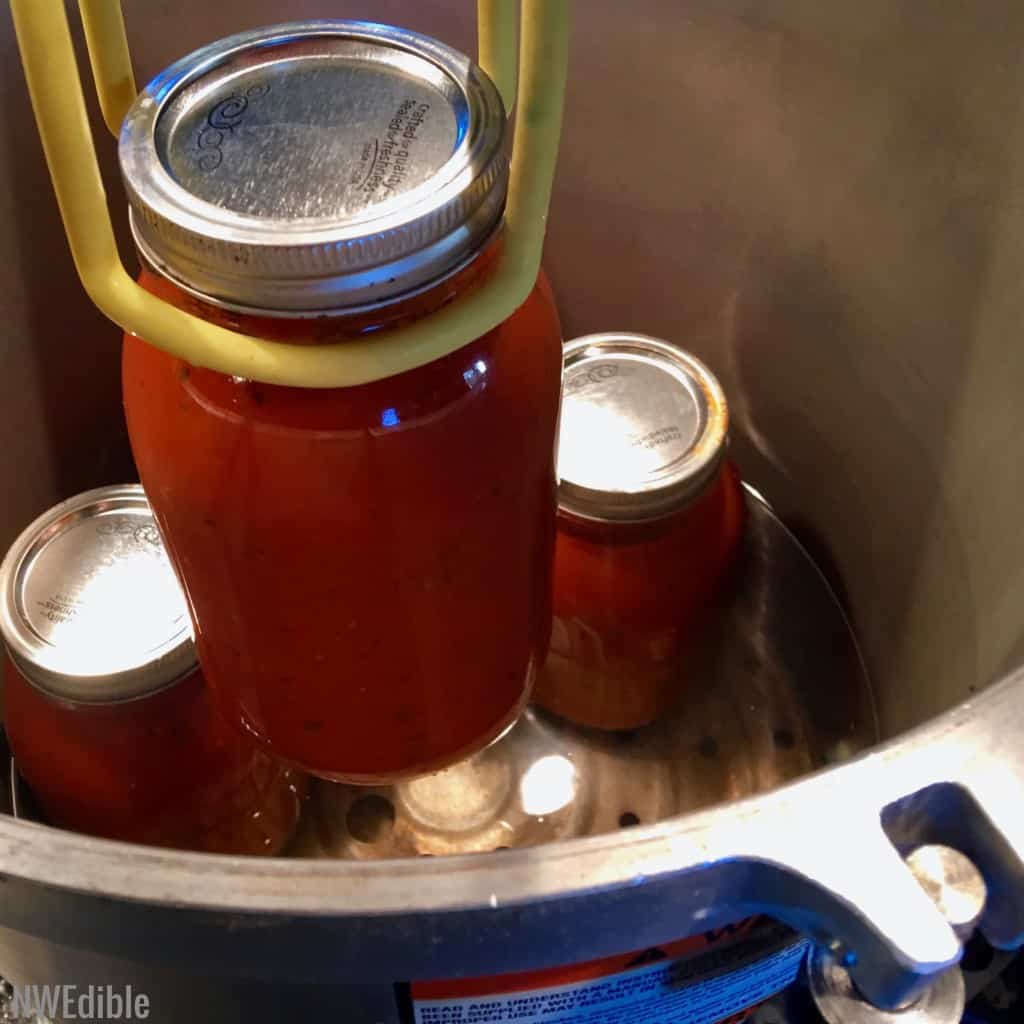
3. Modifications
As mentioned, you can modify dry herbs all you want. I think the herbs called for here will get you very close to that Ragu flavor without any specific herbal flavors really standing out.
If you’re reading this and thinking, “oh this sauce sounds good but actually I love oregano” go ahead and add some. You can add, remove, modify or substitute dry herbs as much as you want. This includes thyme, bay, black pepper, oregano, chili flakes – whatever you might prefer in your pasta sauce.
Similarly, you can reduce the sugar or salt in this base recipe. Because I’m deliberately aiming for a commercial style sauce, both sugar and salt levels are quite high. If you are on a reduced sugar or sodium diet, you can cut either way down. Or – if your tastebuds are a little crazy – you could increase them, too.
The only thing I can’t recommend playing around with, from a safety perspective, is a change or addition of low-acid ingredients like onions, garlic, etc. Even though this recipe is pressure canned, the total processing time may not be long enough if you start adding additional low acid ingredients.
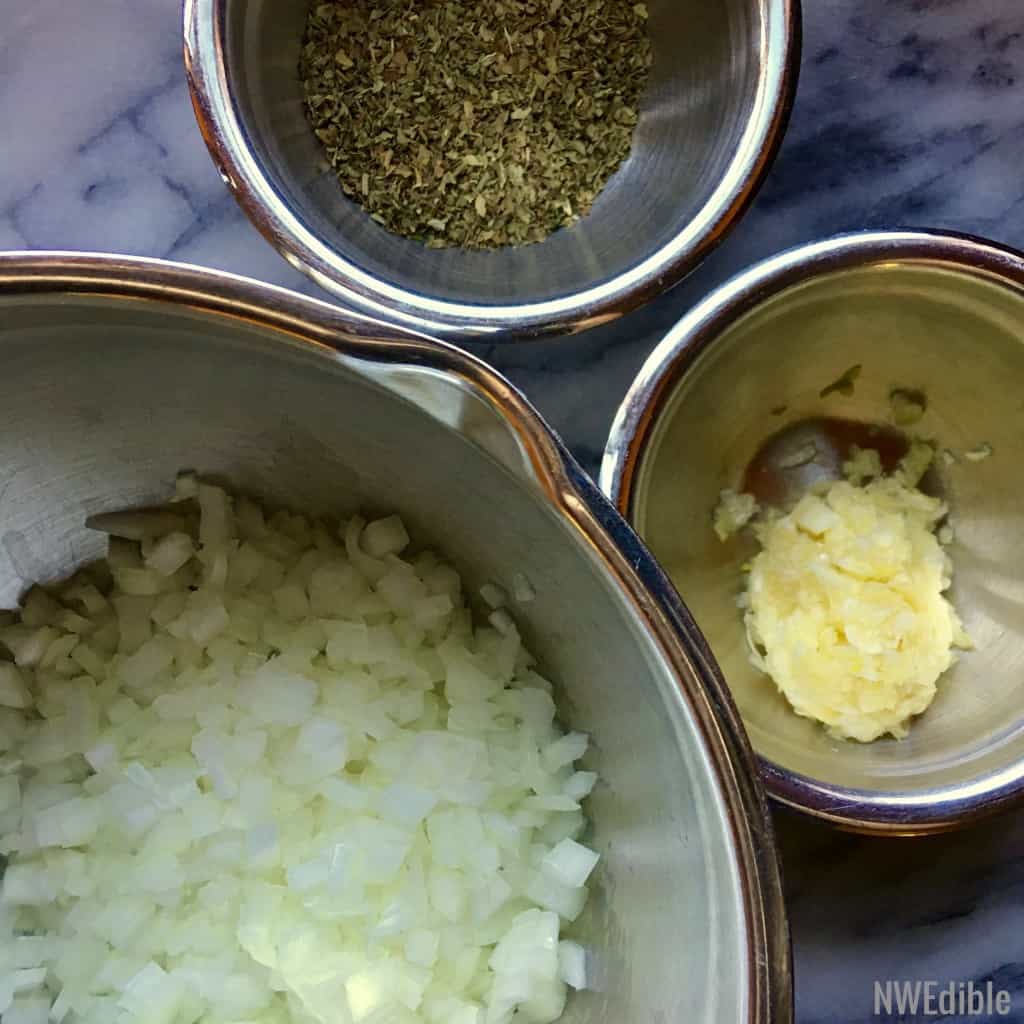
Real Talk: How Close Is This To Ragu?
Despite hours of simmering, I wasn’t able to fully duplicate that long-cooked, slightly metallic tomato paste flavor you get with Ragu. Doubling or even tripling the tomato paste would get the sauce closer, if that’s important to you. But then at a certain point, you should just buy Ragu, know what I mean?
So, this is not a full-on copycat recipe. However, I did manage to create a thick, slightly sweet sauce with very little noticeable acidity that plays in the same category as a commercial pasta sauce. After fiddling and simmering and more fiddling and more simmering, I A/B tested the results of this sauce and the store bought Ragu.
To my palette, the homemade sauce is fresher, slightly less viscous (but still thick), and has a bit more texture than Ragu. My kids, aged 13 and 6, both declared that they preferred the homemade sauce. They praised the texture as better than Ragu and liked the sweetness of the sauce.
I think that if you, your kids, or a family member prefer a mild, thick, store bought sauce, this is a great homemade alternative and possibly a way to start transitioning to more homemade options.

Printable Recipe: Homemade Pasta Sauce For People Who Like Ragu
Home Canned Spaghetti Sauce For People Who Like Ragu
Yield 5 - 7 quarts
Ingredients
- 30 pounds Roma or paste-style tomatoes
- 1/4 cup olive oil
- 1 and 1/2 cups chopped onion
- 3 tablespoons minced garlic
- 2, 6-ounce cans tomato paste
- 1/4 - 1/2 cup white sugar
- 1 and 1/2 - 2 tablespoons kosher salt
- 2 tablespoons dried basil
- 1 tablespoon dried parsley
- 3/4 teaspoons black pepper
Instructions
Prepare the Sauce
- Wash tomatoes, then core and blanch the tomatoes in batches in boiling water for about a minute, or until the skins split. Transfer the tomatoes to a large sheetpan until cool enough to handle, then peel the tomatoes. Here is additional information on how I peel tomatoes quickly.
- Halve, quarter, or crush tomatoes by hand as you transfer all tomatoes and juice to a large, non-reactive pot.
- Bring tomatoes to a boil, then simmer uncovered 30 - 40 minutes, until the tomatoes are very tender.
- Run the tomatoes through a food mill, sieve, or sauce attachment for a stand mixer to capture as as much pulp as possible while leaving behind tomato seeds.
- While tomatoes are simmering, heat the olive oil in a saute pan set over medium heat. Saute the onions and garlic until tender and translucent. Set the onion and garlic aside until the tomatoes are completely food milled.
- In a large, stainless stockpot, combine the sautéed onions and garlic, the food milled tomatoes, tomato paste, 1/4 cup sugar, 1 and 1/2 tablespoon salt, and the basil, parsley and black pepper. Bring to a boil.
- Simmer uncovered, until the sauce is thick enough for serving. This could take several hours depending on the shape of your pot, your stove, etc. Stir frequently while the sauce is simmering to prevent it from scorching on the bottom.
- When the initial volume has reduced by nearly one-half and the sauce is quite thick, taste and adjust seasoning by adding additional salt, up to another 1/4 cup sugar as desired, plus additional black pepper to taste. To my taste, the sweetness is at "commercial" levels at 6 to 7 total tablespoons of sugar, so the original 1/4-cup of sugar, plus 2 to 3 additional tablespoons. However, this will vary slightly depending on the natural sugar-acid balance of your tomatoes, and how far you choose to reduce your sauce. Adjust sugar level to your preferred taste.
- See note for information on reducing sauce and overall yield.
Processing
- Setup for pressure canning, following established guidelines.
- Fill jars, leaving 1-inch headspace.
- Wipe jar rims, then set lids and rings according to manufacturer's directions.
- Load canner with filled, lidded jars, then follow standard pressure canning procedure, including venting canner.
- Process at 10 PSI of pressure for 25 minutes for quarts or 20 minutes for pints, adjusting pressure for altitude (see note).
Notes
Altitude Adjustment For Pressure CanningDial Gauge Pressure Canner Altitude Adjustment: 0 - 2,000 feet: 11 PSI; 2,001 - 4,000 feet: 12 PSI; 4001 - 6000 feet: 13 PSI; 6,001 - 8,000 feet: 14 PSI.Weighted Gauge Pressure Canner Altitude Adjustment: 0 - 1,000 feet: 10 PSI; 1,001 + feet: 15 PSI.Yield VariationsYield will vary depending on tomato type and how much you reduce your sauce. Starting with paste-style tomatoes is highly recommended for this recipe. Reducing by a bit more than half results in an an extremely thick sauce with a yield of about 5 quarts. Reducing by half will result in a very thick sauce yielding about 6 quarts. Reducing by slightly less than half results in a thick but pourable sauce and a yield of about 7 quarts. Reducing down to below a 6 quart yield will require a low heat, lots of patience, and near constant stirring to prevent the sauce from scorching, but will get you a sauce with a texture closer to that of Ragu. Personally, I am perfectly happy with the texture and thickness of the sauce when reduced by nearly half, for a yield of about 7 quarts.
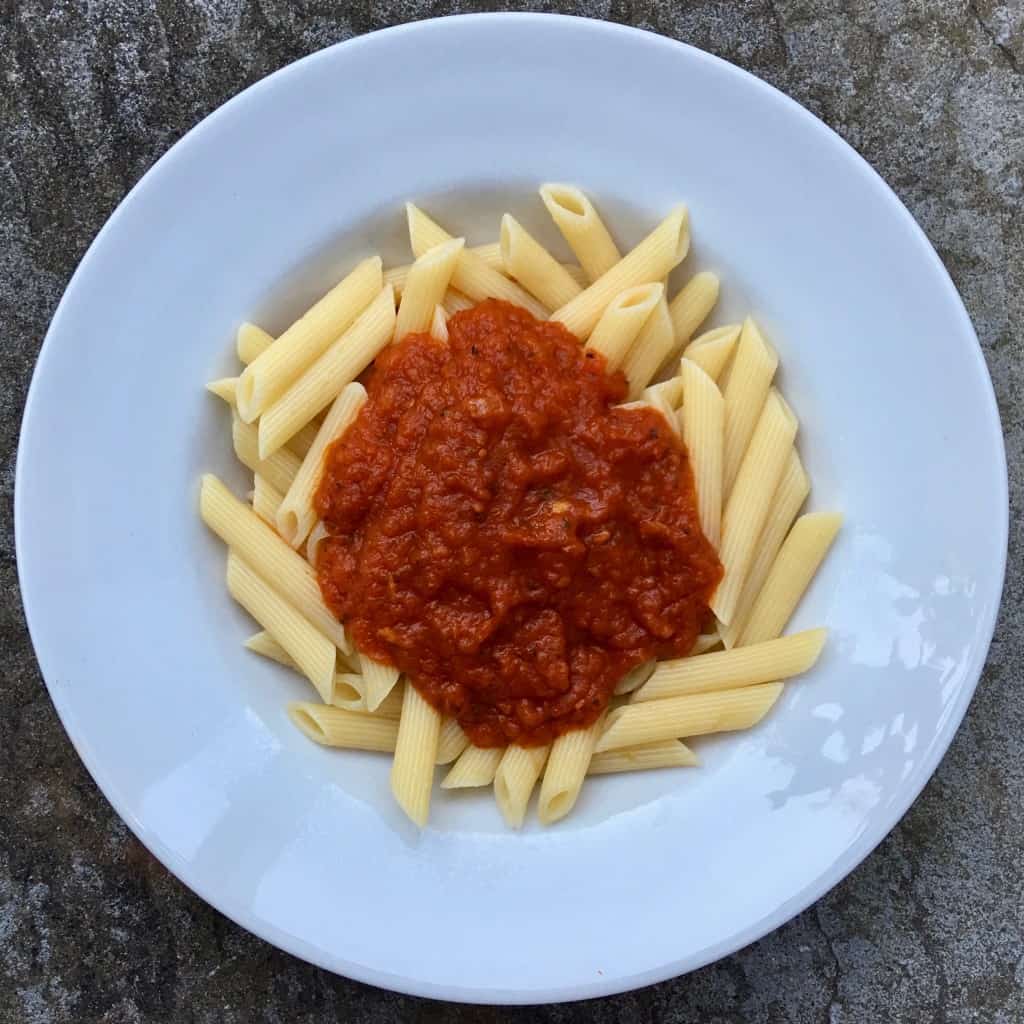
Note: you can listen to the audio version of my response to Matthew on The Survival Podcast Episode 2030.
75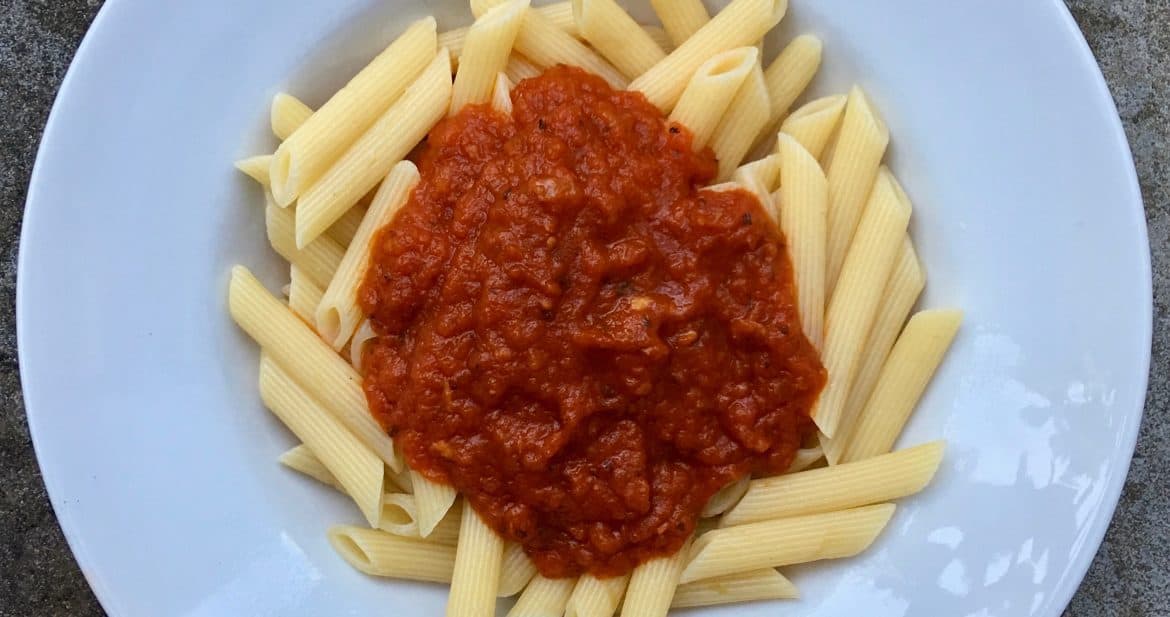
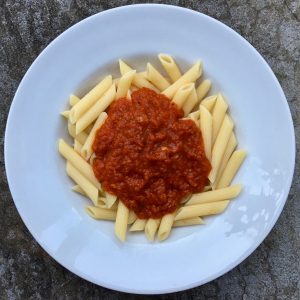
I snagged an All-American pressure cooker on Craigslist (I had a searchbot from IFTTT looking for over a year) and I’m hoping to make some ready-to-use pasta sauce this summer once the tomatoes are in. My favorite way to reduce the volume of tomatoes is to quarter them and convection roast them in the oven, then run them through the food mill after they are cooked. I will roast onions and garlic on the same half sheet pans, and then those go into the sauce as well.
I love oven roasted tomatoes, too! Nice work on the All American. 😀
Wait, you used a what? Is this some internet tool that will do the toy-stalking for you? Computers and I have an adversarial relationship ( they *totally* started it) but I would give my left arm for an All American.
Thanks for posting the recipe! love your segments on the survival podcast, keep up the good work!
Thanks Rendale!
Hey Erica,
I grow about 40 tomato plants every year of about 25 different varieties so I always have tons of tomatoes of varying water content at the end of the season. Usually I am too exhausted by Sept for marathon tomato canning so I just throw them in freezer bags and freeze them whole.
Then when needed I thaw and food mill then prepare as needed and was always frustrated at how long the water takes to cook off, even after draining the thaw water really well. This year I perfected the BBQ reduction method! So after thawing I squeeze the tomatoes out of the skin and then into a shallow, large dutch oven type pan and then cook on medium heat on the BBQ. Works super fast, you get a bit of BBQ flavour in the sauce and it thickens down perfectly and I think enhances their natural sweetness.
It’s a 2 day process but actual hands on prep time only takes like 20 minutes per pan of tomatoes. I did all of my tomatoes this way this year and it was a major time saver.
That sounds great – I love the idea of a smokey, BBQ tomato sauce.
Have you tried with out added sugar?
No because that wasn’t the goal for this recipe. But there is no safety reason for the sugar – you could certainly leave it out.
Everything was going along naize-a naize-a until that photo at the bottom of the post. OUCH!!! I am not even going to say it because it would be too painful even to it type out and give it a life on the page. How could you? How COULD you?! (….slumps head into open hands and whimpers, “managiaaa….man-AGIAAAAAA. . .). 🙂
But thank you for the wonderful recipe. I will try this just for the heck of it. But I will definitely be leaving out the sugar and adding the oregano. Love ALL (yes, even this one) your posts! Ciao, Bella!
This post made me smile from ear to ear. Why? Because I have an adult brother, who still does not like to see any sort of vegetables in his “sauce”. Which is to say, the sauce I make from scratch and water batch can – has to be modified to achieve what he likes…. (spoiled man child alert). I use a hand held immersion blender to puree my marinara sauce prior to canning it. It’s been over 30 years and he still hasn’t figured it out. Also, during the sauce cooking process I throw in a rind or two of Parmesan cheese (I save the rinds in the freezer for uses like this) – it aids in the texture/thickening process and adds another layer of flavor. Just remember to fish it out prior to blending it with the immersion blender. LOL!